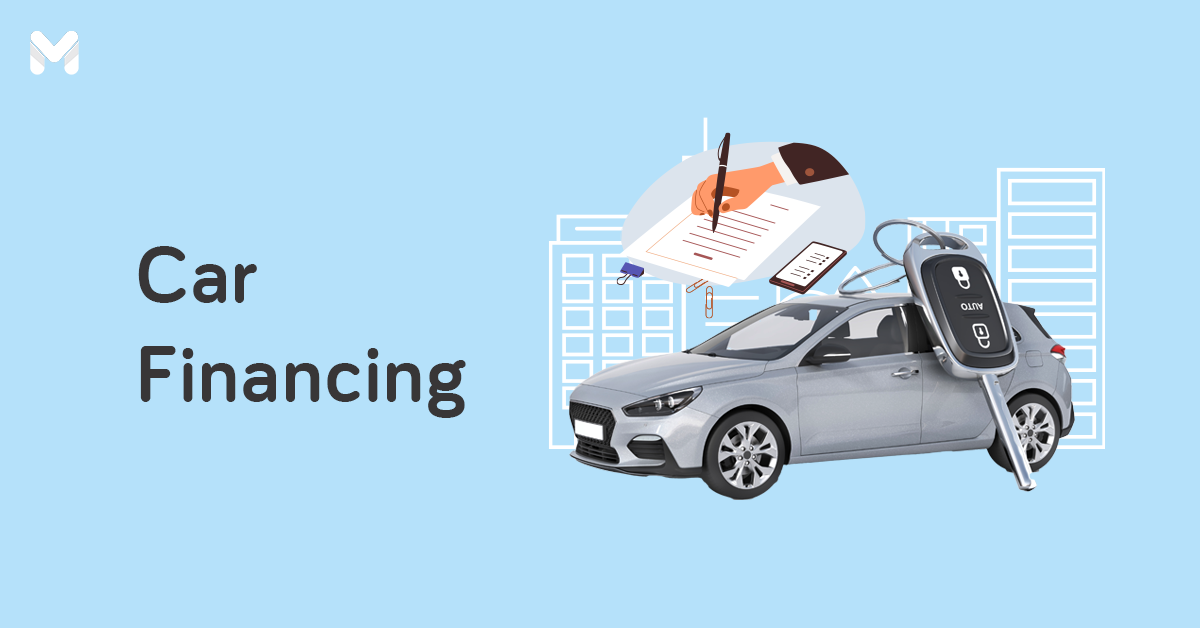Does your existing car loan not work for you anymore? You don’t need to put up with it if it’s putting a dent in your finances.
While loan refinancing isn’t always the answer, sometimes it can be the game-changer that people need to turn their finances around. When you refinance a loan under the right circumstances, you can get lower interest rates, more affordable monthly payments, and better loan terms overall.
But how do you know when loan refinancing is a good move? This article gives you everything you need to know about how to refinance a car loan in the Philippines, including the different factors you need to consider and the steps you need to take to get approved.
Car Loan Refinancing: How It Works

Car loan refinancing[1] is a debt management strategy that involves taking out a new loan to repay an existing one. This strategy works only when you replace an old loan with one that has lower interest rates and better terms overall.
Depending on your need, you can refinance a car loan to either pay off your loan more quickly or stretch it out to unlock a more manageable monthly payment scheme. With the first option, you can get greater savings in the long term by reducing your overall cost of borrowing, while the latter frees up more money for you in the present to either use for essentials, save, or invest.
So when can you refinance a car loan? Car loan refinancing makes the most sense under the right circumstances—i.e., when you secure a higher income and a better credit standing, as well as find a loan with more favorable terms.
Just something to note before you apply for refinancing: make sure to assess your existing loan terms, the current market conditions, and the state of your general finances.
Pros and Cons of Car Refinancing
Planning to refinance an auto loan? Make sure to consider the benefits and potential drawbacks. While there are clear advantages to car loan refinancing, there are also risks to account for.
Here are some pros and cons you need to consider before refinancing an auto loan:
👍 Pro: Lower Interest Rate
When you refinance a car loan, you can reduce your interest rate, which can in turn decrease your monthly payments and lower your debt-to-income (DTI) ratio. With a lower DTI, it’ll be easier for you to apply for a mortgage and ask for better interest rates in the future.
To qualify for lower interest rates when refinancing a car loan, you need to beef up your finances, improve your credit score, and wait for market interest rates to drop. This trifecta will get you significantly better rates. Compare different refinanced car loan rates from multiple lenders to ensure you’re getting the best one.
👍 Pro: Lower Monthly Payment
Two scenarios must be in play for you to qualify for lower monthly payments: first, your lender of choice offers a competitive interest rate, and second, you choose a longer payment term that reduces your monthly dues.
Use your potential lender’s car loan refinancing calculator to see how different interest rates affect your monthly payment and total loan amount. If a longer loan term but reduced monthly payment works for you, go for it. You can invest the difference to grow your money now and earn back the money you’ll potentially lose from extending your loan term.
To get approved for the credit terms you want, you need a good credit score. Having a good credit record to back you up can give you access to better auto loan refinancing rates and payment terms, which will in turn improve your monthly payment rates.
👍 Pro: Flexible Loan Term
Auto loan refinancing gives you a chance to restructure your loan and change your term length. Depending on your goals, you can either shorten or extend your contract.
Lengthening your loan term stretches out the amount you need to pay every month, making payments more manageable. This will give you a bit of wiggle room, especially if your current monthly obligations are hurting your budget. The downside is you will pay a higher loan amount overall.
Conversely, if you shorten your loan term and opt to pay a higher amount every month, you can reduce your total loan amount by saving money on interest. This option also allows you to pay off your debt sooner.
Each option has its own pros and cons, so choose wisely. Also, check with different auto loan refinancing companies to get the best deals that match your chosen term length.
👎 Con: Credit Score Drop
-May-21-2024-03-33-37-2197-AM.png?width=600&height=400&name=Pics%20for%20blog%20-%20600x400%20(1)-May-21-2024-03-33-37-2197-AM.png)
Applying for car loan refinancing and opening a new loan account will prompt lenders to probe into your credit record. They will check your payment history, credit utilization, and overall credit standing to determine your refinancing eligibility.
This hard inquiry into your credit record will reflect in your credit report and cause a temporary hit. Indeed, one of the first things you’ll learn about how to refinance a car loan is the importance of maintaining a good credit score that can withstand a short-term drop.
👎 Con: Negative Equity
With cash-out auto refinancing, you can borrow an extra amount against the equity of your car. However, the downside is that your equity could drop down to negative if your new loan balance is more than the full value of your vehicle. This is also known as being “underwater” on your loan, or your loan being upside-down.
In this case, you should reconsider refinancing lest you hurt your finances.
How to Refinance a Car Loan in the Philippines
-May-21-2024-03-34-55-1608-AM.png?width=600&height=400&name=Pics%20for%20blog%20-%20600x400%20(2)-May-21-2024-03-34-55-1608-AM.png)
There are basic steps you can follow to maximize your chance of getting approved to refinance your car loan:
Step 1: Review Your Current Loan
The first step is to decide if refinancing a car loan is the right move for you. To do that, find your contract and review your current loan. Make sure to understand the following basic information about your loan:
- Monthly payment amount
- Interest rate or annual percentage rate (APR)
- Remaining balance
- Remaining number of payments
Once you have the details above, you can then easily evaluate your current arrangement and gauge if there’s any benefit to gain from refinancing.
It’s okay if you conclude that refinancing isn’t for you. There are scenarios where refinancing won’t solve your problems. Examples include:
- Your loan balance is greater than your car’s value
- You have a short time left to pay off your loan (two years or less)
- You’re behind on payments
- Your car isn’t eligible due to age and mileage
- Your current loan has steep prepayment fees
- You can’t find better interest rates and payment terms
- You’re planning to apply for a mortgage soon
The above scenarios will either lower your chance of getting approved, hurt your credit score and negatively impact your future financing applications, or just defeat the purpose of loan refinancing by canceling out any potential savings you’ll make.
Step 2: Assess Your Financial Standing
Get the full picture not only of your current loan arrangement but also of your current financial situation. Every time you approach a new financial endeavor, like taking out a loan, it’s best to review the state of your finances. This way, you avoid rejection when applying for a car loan.
Refinancing makes sense if, over time, you improved both your credit and your income. With healthier finances, you can get better quotations and deals.
Check your credit report[2] before lenders do so—that way, you can manage your expectations. The higher your credit score, the more likely you’ll get approved with lower interest rates.
You can also calculate your debt-to-income ratio (DTI) by getting the sum of your monthly debt payments and then dividing it by your gross monthly income. A DTI ratio of 35% or lower gets you a higher chance of approval, although some lenders make do with 50% DTI.
Step 3: Know Your Car’s Value
Apart from your current loan arrangement and financial situation, you also have to know the market value of your vehicle. Lenders will appraise your car and determine how much you can borrow based on your car’s value. Depending on your car’s condition, you can get up to 180% of your car’s market price.
Keep in mind that if you have an old or high-mileage vehicle, some lenders might refuse to refinance your loan. To refinance a used car loan is to take on a huge risk as far as a lender is concerned, so you have a higher chance of getting approved with a new car that has a lower mileage.
To get an idea of what your car is worth, check out similar listings on different car dealer sites. You can use the information you gather to know how much you can potentially borrow if you decide to refinance. From there, you can gauge whether refinancing is worth your time.
Step 4: Prepare the Documentary Requirements
Here’s an important piece of advice about how to refinance a car loan: prepare all requirements before you officially submit your application. If you don’t want your hard work to be dismantled at the eleventh hour, prepare to present any document you might be required to produce.
Requirements vary per lender, but there are basic and universal ones you can prepare ahead of time, including the following:
- Driver's license
- Vehicle registration
- Vehicle identification number
- Vehicle’s make, model, year, and mileage
- Proof of insurance
- Copy of original loan contract
- Proof of employment and income
- Proof of residence
- Loan payoff statement
- Remaining balance
- Current monthly payment
- Loan interest
- Amount of time left on your loan
To check for additional requirements, coordinate with your loan provider. Also, take note of the eligibility criteria per lender.
In general, to be eligible for car loan refinancing in the Philippines, you have to be a Filipino citizen aged 21 to 65 at the time of loan maturity. You must also have a stable source of income whether as an employee, freelancer, or business owner.
Step 5: Compare Refinancing Rates and Get Pre-Qualified
Before submitting an official application, check if you can get pre-qualified for a car loan refinancing online. Shop around and get quotes for refinancing rates, repayment terms, and monthly payments. Based on that information, compute your potential savings per lender and narrow down your options to the most competitive offers.
Keep in mind that pre-qualification results don’t guarantee that your actual application will or won’t be approved. It’s intended to be used only as a reference. However, if you get rejected by multiple lenders in the pre-qualification phase, take it as a sign that refinancing isn’t the best option for you.
Once you’ve shortlisted your options, reach out to your existing lender and let them know you’ve found a better rate elsewhere. If they match the offer or present an even better one, you can stick to your original provider and discuss how to restructure your car loan. If they have nothing better to offer, you can proceed with refinancing.
Step 6: Apply for a Car Loan Refinance
If you’re convinced refinancing is a good financial move, it’s time to officially apply. To start, visit the website or go to one of the physical locations of your preferred lender. Fill out the application form and submit your requirements.
Upon receiving your application, the lender will go through the same preliminary steps you took—i.e., review your financial capacity, check your credit record, and appraise your vehicle, among others. Provided you submit the complete requirements, you can expect the background check to last between a few days and a couple of weeks.
You’ll be notified if your application to refinance a car loan is approved. After which, the lender will either pay off your loan directly and then issue you the agreed loan payment terms, or disburse the loaned amount to your bank account, leaving you to pay off your loan yourself and do what you would with the rest of the money.
Step 7: Set Up Automatic Payments
Take your approved car loan refinancing application as a second chance to sort out your finances. Be a responsible payor by always paying on time and in full. Since refinancing can slightly hurt your credit for a short time, it’s important to not miss a payment lest you suffer a more serious dip in your credit record.
To guarantee timely payments every month, set up an automatic payment arrangement with your bank. That way, even if you forget to make a payment, your dues will automatically be paid as long as you have enough money in your bank account.
Best Car Loan Refinancing Options in the Philippines
-May-21-2024-03-36-12-1653-AM.png?width=600&height=400&name=Pics%20for%20blog%20-%20600x400%20(3)-May-21-2024-03-36-12-1653-AM.png)
Some banks that offer car loans also offer car loan refinancing.
It’s not always easy to pinpoint the best auto loan refinancing provider as there are many factors in play. But you can look at their basic features and see how they compare:
| Lender | Interest Rate | Downpayment | Loanable Amount | Loan Terms |
| Security Bank[3] |
Standard: 6.77% to 37.63% With One-Month Advance: 6.02% to 36.38% |
Minimum of 20% of purchase price |
Maximum:
|
New: 12 to 60 months Used: 12 to 48 months |
| EastWest[4] |
Brand New
Second Hand
|
Minimum of 20% of purchase price |
Minimum: ₱200,000 Maximum: 80% of the vehicle’s selling price |
New: 12 to 60 months Used: 12 to 48 months |
| Maybank[5] | 1.06% to 1.42% monthly | N/A | Maximum: 60% of vehicle’s appraised value |
New: 12 to 60 months Used: 12 to 36 months |
| PNB[6] | 5.15% to 28.76% | 20% to 50% of purchase price |
Maximum
|
12 to 60 months |
| Robinsons Bank[7] |
Standard: 5.02% to 28.76% With One-Month Advance: 4.31% to 27.70% |
Minimum of 20% of purchase price |
Maximum
|
New: 12 to 60 months Used: 12 to 48 months |
How to Refinance a Car Loan in the Philippines: FAQs
-May-21-2024-03-38-50-8590-AM.png?width=600&height=400&name=Pics%20for%20blog%20-%20600x400%20(4)-May-21-2024-03-38-50-8590-AM.png)
Here are other questions you might want answers for:
1. Can you refinance a car loan as a foreigner?
Yes, as long as you have a Filipino co-maker or have been residing in the Philippines for a set amount of time, usually at least a year. Apart from meeting these conditions, you might also be asked to produce a valid Alien Certificate of Registration (ACR).
2. Can you refinance a car loan with the same bank?
Generally, yes. But it still depends on your lender, as not every loan provider offers refinancing.
Check with your lender if they offer this option. If they do, present them with the different rates offered by other loan providers. From there, negotiate a better loan arrangement.
3. How do you refinance a car loan with bad credit?
While you can refinance a car loan with bad credit, it’s not necessarily a good idea. It limits your options to a meager few, with interest rates and loan terms that won’t be as good as when you apply with a decent credit to back you up. Ultimately, it defeats the purpose of what you’re trying to do.
There’s only one responsible way to approach loan refinancing, and that is to improve your income while simultaneously keeping a strong and solid credit standing.
Related: Fully Paid Car Loan? Here’s What You Should Do Next
Final Thoughts
Armed with knowledge of how to refinance a car loan, you should now be able to decide if this option is right for you. Should you choose to apply for car loan refinancing, make sure to maximize your chance of getting approved by improving your finances and securing a decent credit score.
Compare different offers from different loan providers, and choose the most sensible option where your gains will significantly outweigh any potential losses. Do your due diligence to make sure you’ll get the most value out of your decision.
Sources:
- [1] Unlocking Financial Freedom: A Guide to Loan Restructuring & Loan Refinancing in the Philippines (Tonik, 2023)
- [2] About Your CIC Credit Report (Credit Information Corporation website)
- [3] Security Bank Car Loan (Security Bank website)
- [4] EastWest Bank Auto Loan (EastWest Bank website)
- [5] Maybank Auto Loan Refinancing (Maybank website)
- [6] PNB Auto Loan (PNB website)
- [7] Robinsons Bank Go! Auto Loan (Robinsons Bank website)










